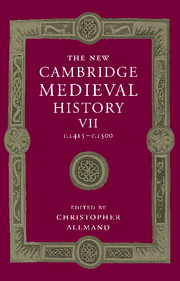Book contents
- Frontmatter
- PART I GOVERNMENT
- PART II ECONOMIC AND SOCIAL DEVELOPMENTS
- PART III SPIRITUAL, CULTURAL AND ARTISTIC LIFE
- 10 Religious Belief and Practice
- 11 Schools and Universities
- 12 Humanism
- 13 Manuscripts and Books
- 14 The Beginning of Printing
- 15 Architecture and Painting
- 16 Music
- PART IV THE DEVELOPMENT OF EUROPEAN STATES
- Appendix Genealogical Tables
- Primary Sources and Secondary Works Arranged by Chapter
- Index
- Frontispiece
- Plate section
- Map 1 European towns in the late Middle Ages
- Map 2 European commerce and trade
- Map 4 Winds and currents facilitating the discoveries
- Map 5 The universities o f Europe in 1400 and 1500
- Map 6 Germany and the Empire
- Map 20 The Roman Orthodox and Ottoman worlds in the fifteenth century
- References
15 - Architecture and Painting
from PART III - SPIRITUAL, CULTURAL AND ARTISTIC LIFE
Published online by Cambridge University Press: 28 March 2008
- Frontmatter
- PART I GOVERNMENT
- PART II ECONOMIC AND SOCIAL DEVELOPMENTS
- PART III SPIRITUAL, CULTURAL AND ARTISTIC LIFE
- 10 Religious Belief and Practice
- 11 Schools and Universities
- 12 Humanism
- 13 Manuscripts and Books
- 14 The Beginning of Printing
- 15 Architecture and Painting
- 16 Music
- PART IV THE DEVELOPMENT OF EUROPEAN STATES
- Appendix Genealogical Tables
- Primary Sources and Secondary Works Arranged by Chapter
- Index
- Frontispiece
- Plate section
- Map 1 European towns in the late Middle Ages
- Map 2 European commerce and trade
- Map 4 Winds and currents facilitating the discoveries
- Map 5 The universities o f Europe in 1400 and 1500
- Map 6 Germany and the Empire
- Map 20 The Roman Orthodox and Ottoman worlds in the fifteenth century
- References
Summary
few epochs in the history of art occupy so central a position in western achievement yet so strongly resist the neat distinctions of period and categorisation as the fifteenth century. Suspended between two pan-European artistic styles (a Parisian-centred Gothic and a Roman-based High Renaissance and Early Baroque), and straddling two historical epochs (‘the late Middle Ages’ and ‘the Renaissance’), the arts of fifteenth-century Christendom, known variously as ‘late medieval’, ‘early Renaissance’, ‘late Gothic’, even ‘florid’ and ‘flamboyant’, present a confusing and extraordinarily heterogeneous picture. The period saw one of the most profound changes in visual language in the history of western art, from the late Gothic formalities of the so-called International Style of c. 1400, to the accomplished naturalism of Leonardo da Vinci and Michelangelo. In a Europe fragmented by complex political units and sharpening differences in vernacular languages, the fifteenth century is remarkable for an acute diversity of artistic styles.
Keywords
- Type
- Chapter
- Information
- The New Cambridge Medieval History , pp. 299 - 318Publisher: Cambridge University PressPrint publication year: 1998



